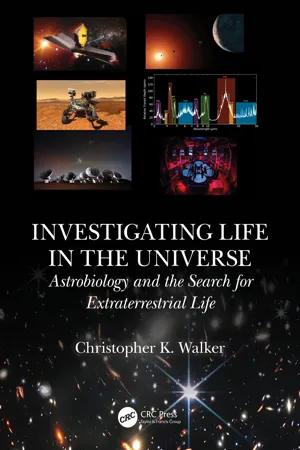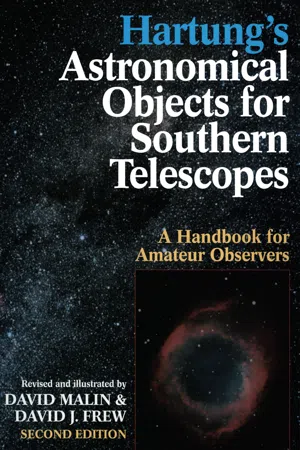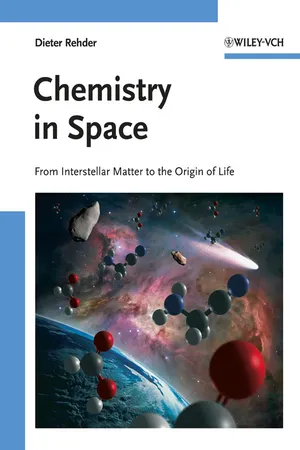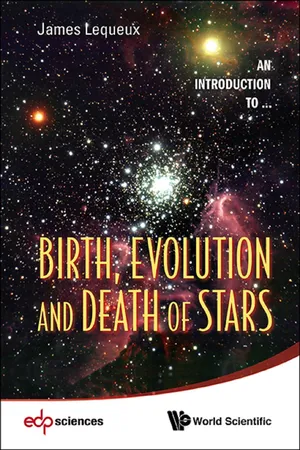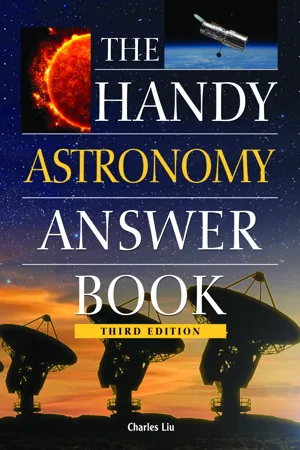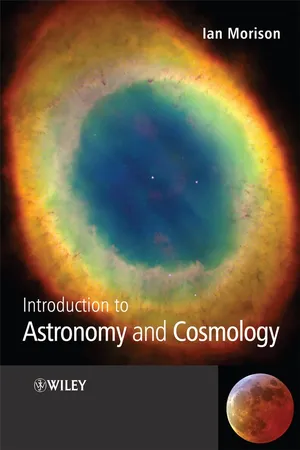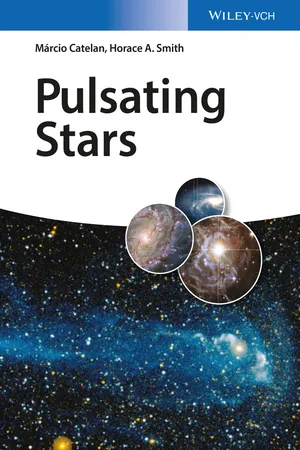Physics
Classification of Stars
Classification of stars is a system of categorizing stars based on their spectral characteristics. The classification is based on the temperature, color, and spectral lines of a star. The most commonly used classification system is the Morgan-Keenan (MK) system.
Written by Perlego with AI-assistance
Related key terms
Related key terms
1 of 4
Related key terms
1 of 3
8 Key excerpts on "Classification of Stars"
- eBook - ePub
Investigating Life in the Universe
Astrobiology and the Search for Extraterrestrial Life
- Christopher K. Walker(Author)
- 2023(Publication Date)
- CRC Press(Publisher)
Boltzmann 1884 ). It relates three fundamental properties of black bodies: luminosity, temperature, and size. In the case of stars, the temperature can be inferred from their spectral class and the luminosity determined from knowledge of their apparent brightness and distance.4.5 The Hertzsprung–Russell (H–R) Diagram
The next step in understanding the true nature of stars began by comparing the spectral classification and brightness of stars located at the same distance from Earth. This was first done in a paper by Hans Rosenberg in 1910, where he made an x–y plot of the apparent brightness of members of the Pleiades star cluster as a function of spectral type as determined from the strength of their hydrogen and calcium absorption lines (see Figure 4.5 ). Looking at the plot, the first thing he noticed was that the brightness of the stars was “a pure function” of their spectral type. Since members of the cluster are effectively at the same distance from the Earth, this meant that the power output, i.e., luminosity, of each star was also a function of spectral type. Shortly after, a more well-known paper showing similar results for both the Pleiades and Hyades star clusters was published by Ejnar Hertzsprung (Hertzsprung 1911 ).FIGURE 4.5First plot of Stellar Brightness vs. Spectral Class. The dots represent members of the Pleiades star cluster. Since they are at approximately the same distance, their brightness can be compared directly. A clear correlation between brightness and spectral class can be seen. Image: adapted from Rosenberg 1910 .While observing stars in clusters provides a means of assessing the relative properties of stars within a cluster without knowledge of the actual distance to the cluster, the true absolute magnitude and therefore the luminosity of stars remains unknown. However, by the spring of 1913, the distances to several hundred stars had been determined using the parallax technique described in Figure 3.5 . These distance determinations together with the associated stellar classifications allowed Henry Russell to make the first “modern” diagram of stellar absolute magnitude versus spectral type (Russell 1913 ; see Figure 4.6 ). This diagram, now referred to as the Hertzsprung–Russell or H–R diagram, will turn out to be as important for understanding stellar evolution as Hubble’s diagram (Figure 3.14 - David Frew, David Malin(Authors)
- 2016(Publication Date)
- Melbourne University Press Digital(Publisher)
Of course, the colours that are recorded as simple numbers in the colour indices of stars can be seen as well as measured, irrespective of the origin of the colour change. However, black-body colours are pastel shades and the eye is a poor discriminator of colour when the light levels are low and the angular size of the source is small. This is why distinct hues are only really noticed when pairs or groups of differently coloured stars are seen close together in the same field of view. The perceived colour is then strongly influenced by a contrast effect, a topic discussed at some length by Malin and Murdin (1984). This fact was also well known to the author of the first edition of this book. Hartung’s original descriptions, many of which are preserved here, are replete with references to pairs of stars that have contrasting colours. Unfortunately, but probably driven by a long tradition, the colours described by Hartung are often given non-systematic, non-black-body names, with objects identified in the description section as ‘ashy’ (612 in the main Table), ‘slate’ (number 120), or ‘reddish grey’ (number 114). While these may be poetic, they are hardly helpful.Classification of Stars
Within these pages we occasionally refer to a star by its colour index, based on the B−V two-colour system mentioned above. While this has proved to be a very useful way of classifying stars, especially in the form of the Hertzsprung–Russell diagram, which compares colour and magnitude, it is not enough to distinguish their finer points. For this we must consider stellar spectra, a field of investigation pioneered by Angelo Secchi in the 1860s. Secchi looked at the stars through a direct-vision spectroscope of the kind used by Hartung.With few facts known about the constitution of the stars themselves, Secchi initially divided stars into five spectral types, I–V, later expanded by E. C. Pickering into a larger number of divisions identified by letters of the alpabet. The first large photographic survey of the spectra of stars was undertaken at Harvard College Observatory initially by Pickering in 1886. The stellar classifcations were done by Williamina P. Fleming and were initially arranged from A to Q in an order largely determined by increasing spectral complexity. Pickering published the first Henry Draper Catalogue in 1890. It is from this catalogue and its successors that the HD (Henry Draper) star identifications come. Later, Antonia Maury and Annie J. Cannon continued and expanded the work and Cannon alone examined the photographic spectra of over 300 000 stars (Hearnshaw 1986, Weither 1984). They dropped some classes and reordered others into the OBAFGKM sequence that is familiar today. This is based on surface temperature, with O stars the hottest, M stars coolest. The basic characteristics of the major types are listed in Table 4 .Most stars can be classified in one of the groups mentioned above, but this still leaves about 10 per cent that cannot. As in many sciences, the study of the unusual helps to better define what is normal, so these stars are of great interest. Among the rarer kinds of stars, some have temperatures similar to the cool G , K and M stars in Table 4 , but they have intense molecular absorption bands, most prominent in the blue region of their spectra, largely due to molecular carbon. The extra intrinsic blue absorption gives these stars an unusually red appearance. Initially known as types R and N , such ‘red’ stars are now known as C , or carbon stars (Keenan 1993). Another group of stars, class S , are cool, giant stars with spectra revealing the presence of refractory oxides from such metals as yttrium, zirconium and barium. Another important group are the rare Wolf–Rayet stars, named for their French discoverers. Wolf–Rayet stars are massive, hot, extremely luminous stars characterised by their unusual chemical compositions, and they are divided into subtypes WN , WC and WO , depending on which element (nitrogen, carbon or oxygen) is over-abundant in their atmospheres. Both carbon stars and the Wolf–Rayets are mass loss- eBook - ePub
Chemistry in Space
From Interstellar Matter to the Origin of Life
- Dieter Rehder(Author)
- 2011(Publication Date)
- Wiley-VCH(Publisher)
3.1b ); track 2: expansion to a red giant by H fusion in the star’s shell; track 3: recontrac- tion after He fusion in the core has ceased; track 4: AGB, the second red giant state by He fusion in the shell; track 5: mass loss (PN); track 6: final stage (development toward a white dwarf). See text for additional details.Once formed, stars evolve, and path and speed of the evolution of a star very much depend on its initial mass. The present situation of the various states of development of visible stars, snapshot in present time, is represented by the Hertzsprung-Russel (HR) diagram in Figure 3.2 , In this depiction, the "magnitude" or "luminosity" of a star is plotted against its surface temperature as a measure of the star’s overall activity and hence its overall mass. The surface temperature is correlated to the color as it appears in the visible range: high surface temperature stars appear bluish, low surface temperature stars reddish. According to their surface temperature (or color index; see below), the stellar classes O (very hot), B, A, F, G, K, and M (relatively cold) are distinguished, sometimes further extended to L and T. The mnemonic "Oh Be A Fine Girl (or Guy), Kiss Me" may be employed to memorize this sequence. Table 3.1 provides an overview of properties associated with these spectral classes, Some chemical characteristics of type M dwarfs and type L and T subdwarfs supposedly have certain properties in common with exoplanets of the categories "hot Jupiters" and "super- Jupiters," and will briefly be dealt with in Chapter 6. The steps between the spectral classes are further subdivided by 10, for example, G0-G9, with G0 being the hottest within the G class. Our Sun is a G2 type star. The "color index" indicates the difference in magnitude at short and long wavelengths, viz. ultraviolet minus blue (U-B index) or blue minus green-yellow (B-V index; V for visible). The smaller the color index, the more pronounced is the contribution of shorter wavelengths.1) For the B-V - eBook - ePub
- James Lequeux(Author)
- 2013(Publication Date)
- WSPC(Publisher)
After measuring the radial velocity of the components by spectroscopy using the Doppler–Fizeau effect, we apply Kepler’s laws to obtain the masses of the individual stars. 1 The comparison of the masses obtained in this way with luminosities give a remarkable result: for main sequence stars, mass is closely related to luminosity (Figure 2.5). The more massive the star, the more luminous it is. We derive from this an important property: the lifetime on the main sequence is shorter for more massive stars. Indeed, this lifetime goes like the ratio of the mass (the reservoir of energy) with luminosity (the rate of consumption of this energy). The lifetime of the Sun is of the order of 10 billion years, but that of a 10 M star, whose luminosity is about 10 000 times higher, is only 10 million years. Figure 2.3. A Hertzprung–Russell diagram, where the representative zones for different types of stars and their evolutionary tracks are indicated in a schematic way. Figure 2.4. The HR diagram of the star cluster M 67. All the stars in this cluster have the same age of 4 billion years, and their abundances in heavy elements are close to that in the Sun. The line represents the theoretical locus where stars of this age are found. Stars of the red giant branch and the asymptotic giant branch have almost all the same mass, slightly larger than that of the Sun, because their evolution is fast. The stars which are outside the line are probably double stars. From Carraro, G. et al. (1996) Astronomy & Astrophysics 305, 849, with permission of ESO. 2.2 Stellar atmospheres The visible spectrum of most stars consists of a continuum with atomic absorption lines (also molecular absorption lines for the coldest ones). Wolf–Rayet stars, which have emission lines, are a remarkable exception - Britannica Educational Publishing, Erik Gregersen(Authors)
- 2009(Publication Date)
- Britannica Educational Publishing(Publisher)
Main-sequence stars range from very luminous objects to faint M-type dwarf stars, and they vary considerably in their surface temperatures, their bolometric (total) luminosities, and their radii. Moreover, for stars of a given mass, a fair spread in radius, luminosity, surface temperature, and spectral type may exist. This spread is produced by stellar evolutionary effects and tends to broaden the main sequence. Masses are obtained from visual and eclipsing binary systems observed spectroscopically. Radii are found from eclipsing binary systems, from direct measurements in a few favourable cases, by calculations, and from absolute visual magnitudes and temperatures.Average values for radius, bolometric luminosity, and mass are meaningful only for dwarf stars. Giant and subgiant stars all show large ranges in radius for a given mass. Conversely, giant stars of very nearly the same radius, surface temperature, and luminosity can have appreciably different masses.STELLAR STATISTICSSome of the most important generalizations concerning the nature and evolution of stars can be derived from correlations between observable properties and certain statistical results. One of the most important of these correlations concerns temperature and luminosity—or, equivalently, colour and magnitude.HERTZSPRUNG -RUSSELL DIAGRAMWhen the absolute magnitudes of stars (or their intrinsic luminosities on a logarithmic scale) are plotted in a diagram against temperature or, equivalently, against the spectral types, the stars do not fall at random on the diagram but tend to congregate in certain restricted domains. Such a plot is usually called a Hertzsprung-Russell diagram, named for the early 20th-century astronomers Ejnar Hertzsprung of Denmark and Henry Norris Russell of the United States, who independently discovered the relations shown in it.As is seen in the diagram, most of the congregated stars are dwarfs lying closely around a diagonal line called the main sequence. These stars range from hot, O- and B-type, blue objects at least 10,000 times brighter than the Sun down through white A-type stars such as Sirius to orange K-type stars such as Epsilon Eridani and finally to M-type red dwarfs thousands of times fainter than the Sun. The sequence is continuous; the luminosities fall off smoothly with decreasing surface temperature; the masses and radii decrease but at a much slower rate; and the stellar densities gradually increase.- eBook - ePub
- Charles Liu(Author)
- 2013(Publication Date)
- Visible Ink Press(Publisher)
F5V (blue-green dwarf) 11.40 Procyon B DA (white dwarf) 11.40 61 Cygni A K5V (orange dwarf) 11.40 61 Cygni B K7V (orange dwarf) 11.40 Struve 2398 A M3V (red dwarf) 11.53 Struve 2398 B M4V (red dwarf) 11.53 Groombridge 34 A M1V (red dwarf) 11.62 Groombridge 34 B M3V (red dwarf) 11.62* These stars are in the Alpha Centauri system.DESCRIBING AND MEASURING STARS
How do astronomers describe and organize the types of stars in the universe?Astronomers organize stars into types based primarily on their colors and surface temperatures. There are seven main categories of stars; they are called stellar spectral types, and each is identified by a letter—O, B, A, F, G, K, or M. Stars of Type O have the bluest colors, and the highest surface temperatures compared to other stars. On the other end, stars of Type M have the reddest colors and the lowest surface temperatures.Who helped establish the modern system of stellar spectral types?A number of astronomers, over many years, worked to create a scientifically sensible classification system for spectral types. The three astronomers who were probably most influential in establishing the OBAFGKM sequence were Williamina Flem ing (1857–1911), Antonia Maury (1866–1952), and Annie Jump Cannon (1863–1941). The order of the letters in the spectral sequence came about because there were originally more than seven types, and because the types were first identified in ways other than the colors of stars. To avoid confusion, these astronomers decided to move the order of the types around to make scientific sense, instead of creating brand-new types. Although unusual, the letter order stuck, and the system is still being used today—more than a century after its establishment.What is the spectral type of the Sun?Our Sun is a type G star, which means it is in the middle of the range when it comes to stellar colors and surface temperatures. To add more detailed information, astronomers often add an Arabic numeral and a Roman numeral after the spectral type letter for stars. In that case, the Sun’s spectral type is written G2V. The 2 means that the Sun is closer to a type F star than a type K star, and the V means that the Sun is not a giant star but rather a main-sequence star. - eBook - ePub
- Ian Morison(Author)
- 2013(Publication Date)
- Wiley(Publisher)
extinction . (This is the name given to the absorption of light by intervening dust.) This would reduce the observed brightness of a star and so make it appear to be further away. There is, however, a way in which this can be detected and corrected for to some extent. The spectral type will indicate that the star has a particular surface temperature. We have also seen how the temperature can be estimated from the colour index. In the absence of extinction these should be approximately the same. However, dust absorbs more light in the blue (shorter wavelength) end of the spectrum than it does at the red (longer wavelength) end of the spectrum. Thus the light from a star whose light has passed through dust clouds will appear redder than it should. This will alter its colour index and indicate a lower surface temperature than that indicated by the spectral index of the star. From this difference it is possible to estimate the effect on the star’s apparent brightness and so make a suitable correction.6.9 The Hertzsprung–Russell diagram
In the early 1900s, Ejnar Hertzsprung in Denmark and Henry Russell at Princeton University in the USA independently plotted a graph of stellar luminosity against temperature which has become known as the Hertzsprung–Russell diagram (H–R diagram) (Figure 6.6 ). Both axes are logarithmic. The x axis represents temperature. (Note: it increases to the left of the plot.) Instead of using temperature to define the ordinate, both spectral type and the (B-V) colour index can be used as both are directly related to temperature. Henry Russell’s first diagram, published in the journal Nature in 1914, used the spectral type. An observer might use the B-V index and a theorist would be likely to use temperature, regarding this as being the most fundamental. On the plot shown in Figure 6.6 , both the spectral type and the temperature are given.Figure 6.6The Hertzsprung–Russell Diagram.The vertical axis is a measure of brightness. Here, a theoretician might well use a star’s luminosity compared with the Sun, whilst an observer would use absolute magnitude. Russell used the absolute magnitude for this ordinate, but this author prefers the use of luminosity as giving a better understanding of the relative brightness of the stars. When plots are used using the colour index and absolute magnitude, they are often called a colour–magnitude diagram rather than an H–R diagram (Figure 6.7 - eBook - ePub
- Márcio Catelan, Horace A. Smith(Authors)
- 2015(Publication Date)
- Wiley-VCH(Publisher)
Chapter 3 Classification of Variable Stars The main established “authority” in astronomy dealing with the classification of stellar variability is the General Catalogue of Variable Stars (GCVS; Kholopov et al., 1998). This catalog lists extensive definitions, based on a variety of criteria – periods, light curve amplitudes, spectral types, luminosity classes, special spectral features, and so on – for over 110 different classes and subclasses (February 2012 edition), and a few galaxy variability classes as well. 1 As a historical note (Samus, 1998), variable star catalogs had been compiled and published, until 1943, by German astronomers, in the Astronomische Gesellschaft ; however, after World War II, the IAU assigned the project to astronomy groups in Moscow, which is where this important work continues to be carried out to date. However, it is important to note that there is often a degree of ambiguity (and even arbitrariness!) in the definitions of variability classes, and the GCVS classification scheme is not always strictly adhered to in the specialized modern literature. At this point, we wish to remind the reader that a list of the abbreviations and acronyms commonly employed in this book can be found in the Glossary at the end of the text. For example, if the reader has forgotten what AGB stands for, all is not lost, as the Glossary tells us that AGB stands for asymptotic giant branch. 3.1 Regular, Semi-Regular, and Irregular Variables According to their light curve shapes, variables can be classified into three different types, namely regular, semi-regular, and irregular. Regular light curves repeat themselves over time with a well-defined periodicity, whereas irregular light curves show no obvious signs of periodicity, even when the degree of variation may be substantial
Index pages curate the most relevant extracts from our library of academic textbooks. They’ve been created using an in-house natural language model (NLM), each adding context and meaning to key research topics.
Explore more topic indexes
Explore more topic indexes
1 of 6
Explore more topic indexes
1 of 4
